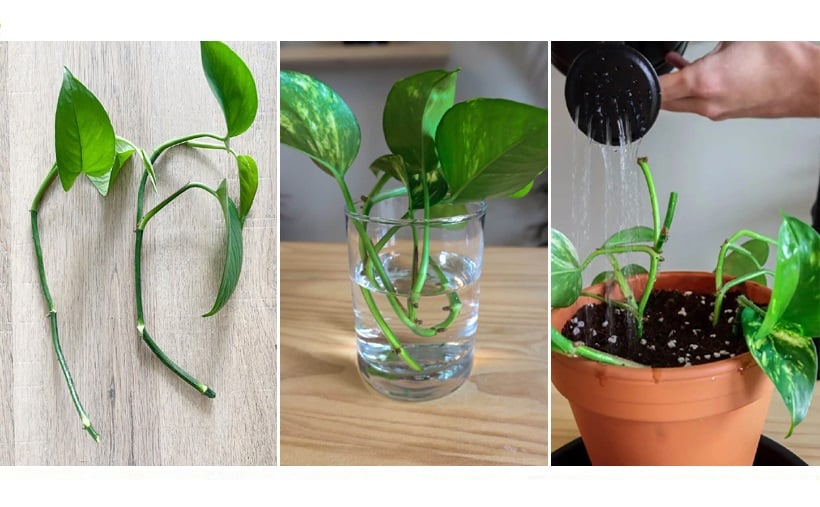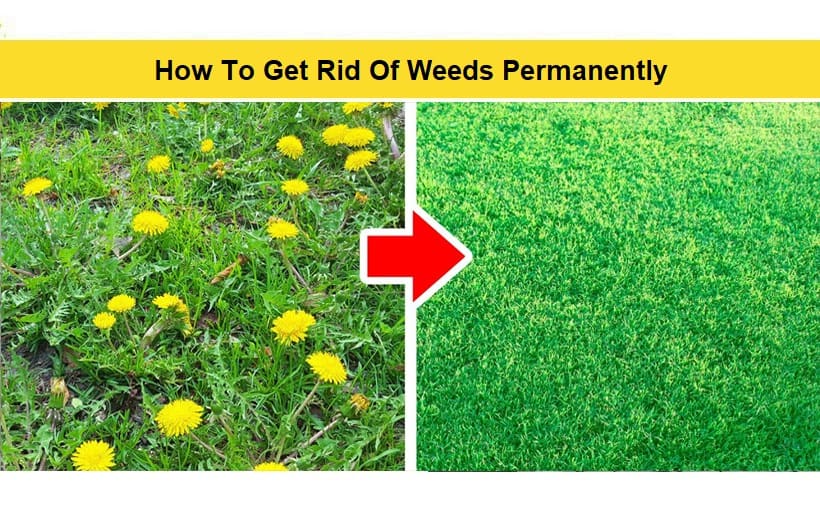Propagating pothos from cuttings is a simple process if you know how to do it properly. Learn more about Propagating Pothos here!

Pothos, also known as Epipremnum Aureum, is an Araceae or evergreen flowering plant. The plant has waxy, heart-shaped, pointed dark green variegated leaves and grows up to 6′ to 10′ feet tall. Pothos vines can grow up to 30 feet long in some cases.
The leaves are usually yellow variegated, although other types have splashed with white, cream, or pale green leaves. Although Pothos plants are primarily flowering plants, they rarely bloom independently.
Its hardiness, low maintenance, appealing leaves, and air purifying properties are regarded. This plant can remove hazardous compounds such as benzene, xylene, toluene, trichloroethene, and formaldehyde from the indoor air.
Hanging from a bookshelf or climbing up a trellis for a vertical living wall feature, they are the perfect home decor piece. But that’s not all; they are also one of the easiest plants to propagate. Follow these simple steps to multiply your pothos plants at no cost.
Propagating Pothos From Cuttings
Pothos propagation is a simple method to multiply your single plant. When your pothos starts to age, become very lean and unruly, or become pot-bound, it’s a good idea to propagate it to give it a fresh start.
Any pothos in a pot will eventually become pot bound, which implies it has used up all of the space and soil in the pot. Lift your pothos gently out of the pot if it starts to droop after a long period in your care. If the roots outnumber the soil, it’s time to consider pothos plant propagation.
Pothos can propagate in two ways: water or soil. But, because most of you are new to plants, let’s start with water (which is much easier) and then go on to the more sophisticated soil.
Propagating Pothos In Water
Prepare cuttings:
1. A good plant needs to get off to a strong start. Choose a healthy plant with leaves that aren’t sick or yellowing to clip. The healthier the stem, the higher the chances of successful rooting.
2. Trim the stem to about 4 inches in length, making at least one leaf node (where the leaf attaches to the stem). I prefer to take longer cuttings with 3-4 leaf nodes (they usually root faster). It’s also easier to stay upright as a result of this.

3. Take a glass and fill it with normal water. Then, simply put the cuttings in water, resting the stems on the side of the glass.

3. Make sure to remove any lower leaves submerged in the container. If the leaves are soaked for an extended period, they can rot, which doesn’t appear to be appealing. Replace the water every couple of days or when it becomes cloudy.
4. Place the glass in an area with bright, indirect sunlight. Your Pothos vine will have roots within a few weeks. You can now either plant your Pothos in soil or keep it in water for the rest of its life. Pothos grows well in water and soil but doesn’t swap the growing medium after establishing itself.
The plant’s health will deteriorate if it is switched from water to soil (or vice versa) later in its life. It could recover, but it’s also possible that it won’t.
Propagating Pothos in Soil:
1. Follow the same instructions for soil cutting as you would for water cutting. It’s also a good idea to remove any leaves covered in soil because they will rot.
2. Rooting hormone is one item that always helps you succeed with cuttings. Dip the cutting into the hormone and shake off the excess powder.
Ensure the rooting hormone is applied to at least one leaf node (the portion of the stem where the leaf connects). You should have two to three nodes on your leafless cuttings to ensure that at least one of them roots successfully.
3. Plant a few cuttings around the edges of the pot. Make sure at least one leaf node is submerged in the soil. When it comes to pots, choose a shallow container that drains properly and use a well-draining potting mix to prevent the cuttings from decaying.

4. The key to watering your cutting is to keep it moderately damp all the time. Don’t overwater your plants. Keep the soil moist by spraying every couple of days and wait for new growth. If your pot/container doesn’t dry out in two days means you’ve oversupplied water.
If your cuttings aren’t doing well, consider one of the soil possibilities mentioned above, as well as switching to a smaller container with plenty of drainage holes.
Reasons Why Your Pothos Cutting Didn’t Root
- You cut the stem in the wrong place.
- You didn’t change the water.
- There isn’t enough light.
- You took a cutting from an old/damaged vine.
- There isn’t enough warmth.
- You transplanted too late.
- They need more time.
Conclusion:
As you can see, propagating and maintaining pothos is simple! Of course, if you want your plant to thrive, you must take care of it. Pothos, fortunately for you, can thrive in a variety of conditions.
You don’t have to worry about not putting it in direct sunlight because it can flourish in low light. When selecting soil, ensure it is nutrient-rich enough for the vine to thrive.
Finally, it might help your eyes relax, especially if they are itchy or clogged. Glaucoma, cataracts, and hypertension are other issues that can be avoided or treated. Now is the moment to begin propagating your pothos to reap the full rewards of your investment.
Also Read
How To Grow & Care For Aloe Vera Plants
How To Grow & Care Monstera Deliciosa
For More Updates like our Facebook Page and join our Telegram Channel.




